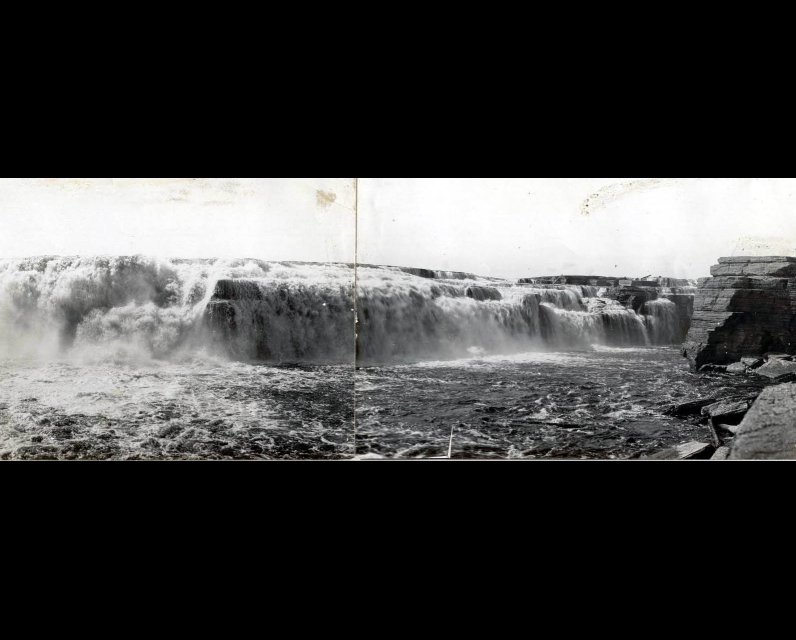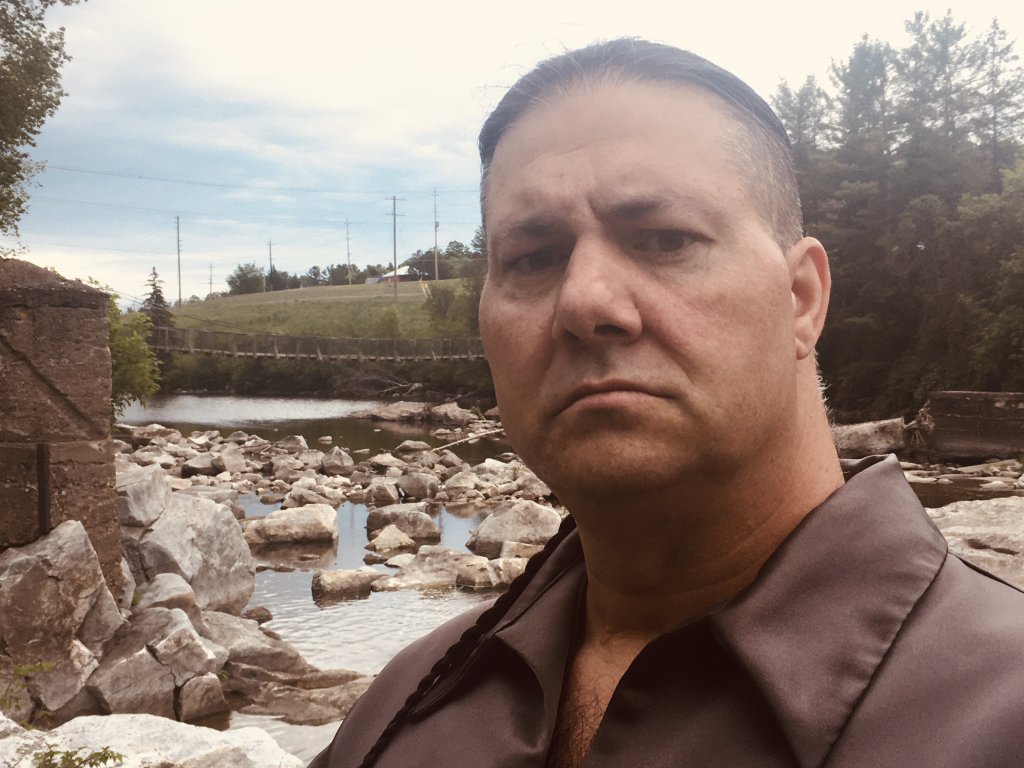Unpublished Opinions
My name is Jason (Rotisken'rakehte) Arbour, Appointed Chief and Legal Representative of Kana:tso Kaniengehaga First Nation. In 1903 my family/band was disbanded from our Indian resserve and place of origin at Gatineau, Quebec. To date, I have been chosen to raise awareness and respectfully represent our community's legal interest of re-establish our historical rights to our traditional territory at the Chaudiere Falls.
I am indigenous to the Ottawa-Hull region of Canada. I was born and raised in Ottawa and I am happily maried with five boys and one grandaughter.
Truth and Reconciliation: How our people moved from an Indian Ossuary to the Hull Cemetery

What follows is a result of my continuing effort to research the origins and life of my Mohawk ancestors who lived in a village called Kana:tso, adjacent the Chaudiere Falls, before their Reserve was removed from its historical location in the early 20th Century by the Ontario provincial court.
On record, it is written that the first settler of European descent to arrive in the Ottawa-Hull region of Canada was Philemon Wright. Philemon Wright was born on September 2nd, 1760, in Woburn, Massachusetts. His family originated from East Peckham, Kent, England.
On April 17, 1797, Philemon Wright petitioned the Crown for a grant of land adjacent the Chaudiere falls, the petition was granted, shortly after. The land was given the name Wrightsville, today, known as Gatineau. Upon Philemon Wrights arrival in March of 1800, the territory was inhabited by an indigenous people who's encampment overlooked the Chaudiere falls, this camp was located at Brewery Creek. The local Indian band or sub-nation did not have in their possession any territorial maps, written records of populations or inhabitants.
The Historical Society Of Ottawa states, Philemon Wright encountered this band of locals. Wright even considered them useful, for they assisted his party off the frozen Ottawa river.
- See pg 9: http://www.wrightfamily.ca/genealogy/histories/Philemon%20Wright%20-%20Edward%20P.%20Laberge.pdf
Original inhabitants of the Chaudiere Falls: Kana:tso
Before Philemon Wright arrived at the Chaudiere Falls, the original inhabitants named the Chaudiere falls, Kana:tso.
Like many other sub-nation communities, this one had distinguished ethnological characteristics and customs. For example for burials, the family or bands' burial ground was located just a short walk below their encampment.
- See pages 160-161: http://www.biodiversitylibrary.org/item/96895#page/192/mode/1up
Perceptions may vary, but it is said by the originals that items were placed in the ossuary to assist the spirit of the deceased upon arrival at their new destination. For example, an agriculturist would have brought gouges for farming and if a warrior survived battle his war club. Although sacred Indian ossuary's varied, a few anthropological similarities between Indian ossuary's include the honoring of clan spirits. In this very case two wolf skulls were honored. Additional unearthed evidence of an agricultural gouge, a war club, as well as other relics, these actions would indeed express great care was taken when burying their deceased at Kana:tso.
In 1820, Philemon Wright raised his spiritual concerns of not having a place for ceremonies, for worship or for burying his deceased. In 1823-24, the St. James Anglican Church and the Hull cemetery were established. Philemon Wright's practice of burying his departed are similar in ways of the local Indigenous inhabitants, ceremonies and offertories of certain plants, flowers, money or even the accompanying of jewelry may be considered comparable. One incomparable difference between cultural practices is the collection of written records at ceremonies or events like marriage, birth, baptism's and of course death.
Respectfully, attached is a link to the St. James cemetery. Here you may receive more historical information and view headstones of those who were entered into the Hull cemetery, approximately one-fifth are bearing the last name 'Wright'.
In 1843, the Indian encampment was now completely enveloped by settlers. Records state, that same year, the settlers had unearthed their sacred Indian ossuary located just below the Chaudiere falls. Today, this act of profanity is illegal, but this act has always been considered sacrilegious and unethical by the local indigenous people.
- See the 1843 Bytown Gazette: http://tsit-kanajakaniengehaga.webs.com/apps/photos/photo?photoid=175750155
Sadly, the first historical records collected by the St. James Church burned in the fire of 1865.
Indian burial and death records after Confederation
In 1865, a new collection of St. James Church records on the local pioneers and Indians began. Through my research, I believe all Indian burial death records after confederation are suspect of falsification. For instance, the validity of 10 Indian death records provided below are extremely difficult to authenticate and may be fraudulent.
For reasons unknown, not one death record of these Mohawk children from Kana:tso has been registered online at the Hull cemetery. Upon further investigation, not one of these Mohawk children can be visibly located in the Hull cemetery either.
#1. Louisa Tay:hakaktah, Indian girl of Hull died on the 31st of January, 1877, and buried in the Hull cemetery on February 2, 1877;
#2. George Laforce, infant son of Louis Laforce of Hull died, 8th of April, 1886, and buried on the 10thof April, same year;
#3. Marry-Anne Laforce, daughter of Louis Laforce of the Indian camp city of Hull and of Marie (Minni:ha:ha) Eustache his wife, died on the 19th day of April 1889 and was buried on the 20th of 1889.
#4. Elizabeth Laforce, daughter of Louis Laforce of the Indian camp Hull and of Minni:ha:ha Eustache his wife, died on the 26th, of April 1889, buried on April, 27th, 1889.
#5. Lovina Eustache, daughter of Louis Eustache city of Hull and of Mary Fraser his wife, died 30th day of September of 1890 and was buried on the 1st day of October 1890.
#6. Michael Jackson, Michael son of Louis Jackson city of Hull, Province of Quebec, died on the 30th of September 1896 and was buried on October 2nd of 1896.
See record: http://tsit-kanajakaniengehaga.webs.com/apps/photos/photo?photoid=203583444
#7. Annie Laforce, daughter of Louis Laforce of the city of Hull and of Minnie Eustache his wife, died on 6th of April 1898 and was buried on 7th day of 1898.
#8. Tom Laforce, Tom son of Thomas our Laforce of the city of Hull, Province of Quebec and of Minnie Eustache his wife, died on the 5th day of July 1901, buried on the 6th day of July 1901.
#9. Wilbert Eustache, son of Louis Eustache city of Hull, Province of Quebec, died on the 19th of November 1903, buried on the 20th, 1903.
#10. Wilbert Cole, adopted son of Stephen Cole of the city of Hull, Province of Quebec and of Annie his wife, died on the 6th day of November 1912 and was buried on the 7th of 1912.
Questions?
1. Did these 10 children really die?
2. If these children had their deaths faked, and their real identities changed, would they lose their aboriginal inherited rights?
3. Is it possible, that these children are buried without headstones, and for this reason can not be located in the Hull cemetery?
4. With today's technological advances, like ground penetrating radar, is it not possible to attempt recovery and confirm burial?
Public inquiry needed
Based on these questions alone, a public inquiry should take place into the possible historical misconduct of the St. James Anglican Church. Why would someone be so suspicious of the Anglican Church practices? And, how can one prove that names of the Kana:tso Mohawk children have been altered, or changed? Please allow me to explain.
In 1900, the Indian Reserve at Kana:tso was burned to the ground.
- See fire records: https://en.wikipedia.org/wiki/1900_Hull%E2%80%93Ottawa_fire
While some community members worked to repair Kana:tso First Nation, some members and children were forced to relocate. Two of the people relocated were Nancy and Joseph Cole, who can be found on census in Cumberland.
Notice that an enumerator had suggested Nancy Cole was really Nancy Takanawjausin, that her name and age is incorrect.
- See original Kana:tso baptism record to support enumerators claim: http://tsit-kanajakaniengehaga.webs.com/apps/photos/photo?photoid=174324623
With this additional information, it is now fair to suggest and suspect the entire household of Cole's had their names replaced and real identities misrepresented while residing at the Indian Reserve in Hull, Quebec. In this Cole household, listed as 146, I now suspect Joseph Cole was originally born Joseph Eustache the 3rd.
- See: http://tsit-kanajakaniengehaga.webs.com/apps/photos/photo?photoid=203587619
- RG 10 Indian Affairs microfilm records: (http://collectionscanada.gc.ca/pam_archives/index.php?fuseaction=genitem.displayItem&lang=eng&rec_nbr=2041255&rec_nbr_list=2 )
In 1934, Joseph Cole stated he was born in 1874, on an Indian Reservation in Hull, Quebec ( 2 years after a Smallpox epidemic, http://unpublishedottawa.com/letter/117132/smallpox-chaudiere-falls-indian-reservation ) and that he was baptized in the Church of England.
The return letter stated that the department is aware of a man from Hull with the last name Cole and who is of Indian descent. But the department can provide no further information about him. I believe the reason no birth or baptism records exist for Joseph Cole are through Indian Affairs is becuase the name 'Cole' was not Joseph's original given name by his parents. As a result, such records would not exist.
It is reasonable to believe Joseph stated he was born in 1874 instead of 1872, so he would meet the age requirements to qualify to fight overseas in WWI, which he did.
If Joseph Cole was indeed originally Joseph Eustache the 3rd, this would also support fraud in one additional death certificate, (see http://tsit-kanajakaniengehaga.webs.com/apps/photos/photo?photoid=203583621 ). Coincidentally this burial can not be located and validated either. While the Kana:tso Indian resident Joseph was buried as Joseph Cole and is located in the Hull cemetery, Province of Quebec.
Truth and Reconciliation
The act of desecration is disrespectful, sacrilegious, and incomprehensible, but this act can be forgiving when and only if the true spirit and intent of reconciliation has been respected. A modern commemoration for the Kana:tso Indian ossuary and missing Mohawk children from the Hull cemetery would indeed show the 'good will' of the Crown. These actions would help build better relations between nations and would respectfully address some of the spiritual concerns the Chaudiere falls Indians face.
Niawen:kowa to Unpublished Ottawa and you the reader for your attention, allowing me this opportunity to respectfully speak on behalf of my ancestors, our Kana:tso Indian ossuary and the Hull cemetery. It has been a humbling experience.
I hope this helps you understand how we at Kana:tso went from the Indian Ossuary to the Hull cemetery. For more facts on the Chaudiere falls Indigenous history, please read my other articles on Unpublished Ottawa and visit, http://tsit-kanajakaniengehaga.webs.com/.
Additional posts on this subject:
- Smallpox at the Chaudiere Falls Indian Reserve
- Kana:tso Mohawk Indian Reserve, Chaudiere Falls
- Truth and Reconciliation: How our people moved from an Indian Ossuary to the Hull Cemetery



Comments
Be the first to comment